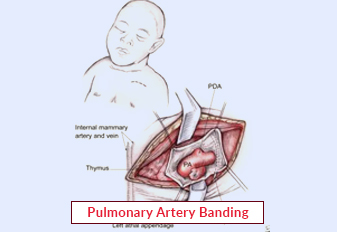Pulmonary Artery Banding

A surgical procedure called pulmonary artery banding (PAB) is performed to palliate some congenital heart abnormalities. The most typical use is for pulmonary blood flow limiting in the clinical setting of massive left-to-right shunts-induced pulmonary overcirculation. When congenital heart palliation first emerged and routine definitive repair wasn't yet a thing, PA banding was frequently the first surgical procedure performed on children who had specific cardiac abnormalities.
The primary objective of performing PAB is to reduce excessive pulmonary blood flow and protect the pulmonary vasculature from hypertrophy and irreversible (fixed) pulmonary hypertension.
Book an AppointmentAbout Pulmonary Artery Banding
A palliative surgical procedure called pulmonary artery banding (PAB) is used to treat congenital heart abnormalities, which are characterized by pulmonary overcirculation brought on by a left-to-right shunting of blood. A certain subgroup of newborns with complicated congenital cardiac disease are designated for PAB palliation.
In the past, this method was frequently employed as the first surgical procedure for newborns with heart abnormalities that included pulmonary overcirculation and left-to-right shunting. Palliation with PAB has mostly been superseded by early definitive intracardiac repair within the past 20 years. This tendency has developed as a result of numerous centers showing that primary corrective surgery, when used as an initial step for neonates with congenital heart disease, improves outcomes.
Procedure of Pulmonary Artery Banding
Pulmonary artery banding is typically performed as open-heart surgery. The procedure involves several key steps:
-
Anesthesia and Incision: Pulmonary Artery Banding Procedure is performed under general anaesthesia. A small incision is made in the chest to access the heart and the pulmonary artery.
-
Placement of the Band: A band or ring made of a biocompatible material, such as Dacron, is carefully positioned around the pulmonary artery. The band is adjustable and can be tightened or loosened to achieve the desired level of constriction.
-
Monitoring and Adjustment: Once the band is in place, the surgeon carefully monitors the patient's blood pressure, oxygen saturation, and other vital signs to ensure optimal cardiac function. The band may be adjusted during the surgery to achieve the desired balance in blood flow and pressure.
-
Closure and Recovery: After the band is appropriately positioned and tested, the incision is closed using sutures or surgical staples. The patient is then transferred to the recovery room, closely monitored for any complications, and provided with appropriate pain management.
-
Follow-up Care: Regular follow-up appointments are crucial to monitor the patient's progress and assess the effectiveness of the Pulmonary Artery Banding Procedure. Adjustments to the band may be made during subsequent visits to ensure optimal blood flow and cardiac function. As the child grows, additional surgeries may be required to remove or adjust the band to accommodate the changing anatomy of the heart.
Require Assistance?
Get A Quick Callback From Our Healthcare Experts
Other Specilities We Cover

Robotic Heart Bypass Surgery

Heart Bypass Surgery




